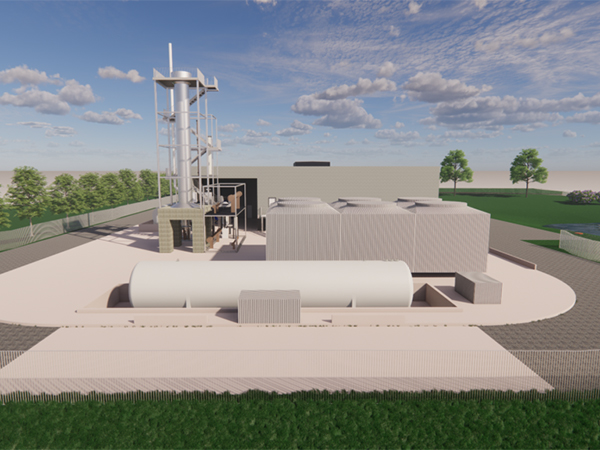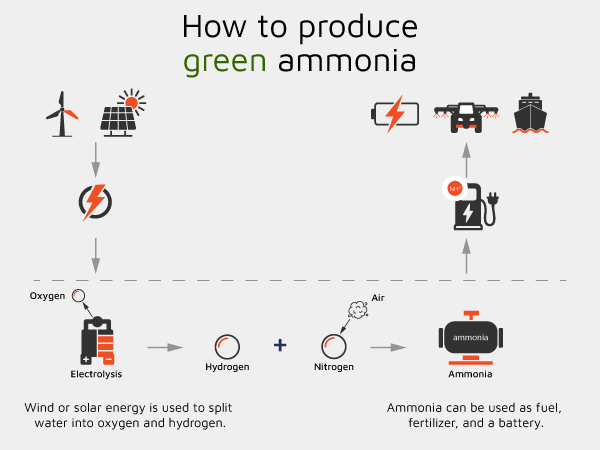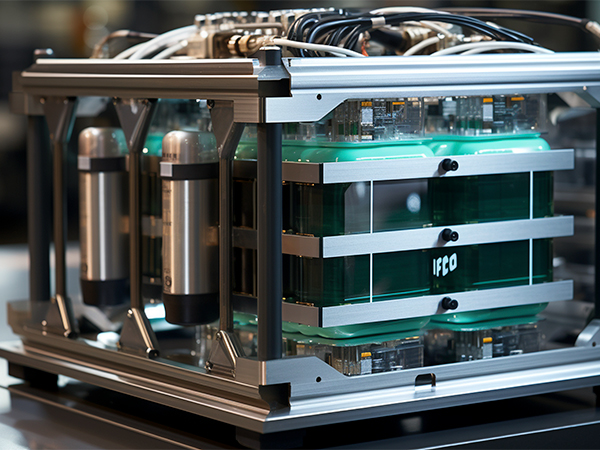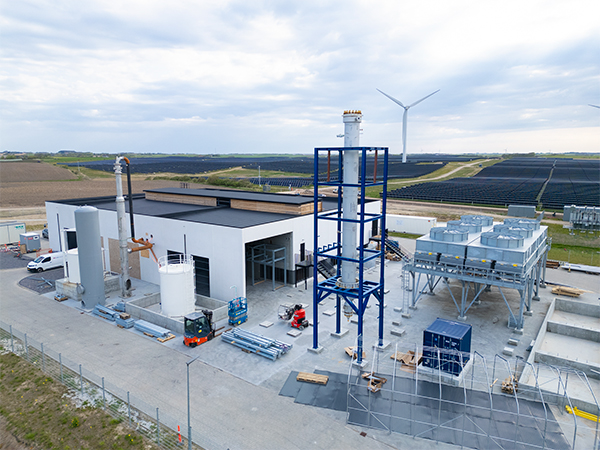Everything you need to know about ammonia as fuel and an energy battery
Content
- Introduction
- Power to X
- What is Green Ammonia?
- Green fuel
- Summary
Introduction
In the constant search for sustainable energy sources, Power-to-X (PtX) technologies are gaining increasing attention. One of the most promising branches of this technology is Power-to-Ammonia, which not only offers clean energy storage but also the potential to produce green fuels. But what exactly does Power-to-Ammonia entail, and how can it be part of the solution to our climate challenges?

A 3D illustration of a revolutionary new PtX ammonia plant, the first of its kind in the world. Photo by Skovgaard Energy.
Power to X
Power-to-X (PtX) refers to technologies that convert electricity into other forms of energy such as gas, heat, and liquid fuels. This technology helps utilize excess energy from wind and solar power that would otherwise be wasted. The biggest advantage of PtX is its ability to store renewable energy, addressing the issue of unpredictable production from wind and solar power.
Watch this video by the Technical University of Denmark (DTU) for insights into Power-to-X technologies.
What is green ammonia?
Ammonia (NH3) consists of nitrogen (N) and hydrogen (H). It is a colorless gas with a sharp odor, primarily used in fertilizers.
Watch this video where Skovgaard Energy explains the potential of ammonia:
Power-to-Ammonia is a process where electrical energy is used to produce ammonia (NH3). The process starts with electrolysis, a method that uses electricity to split water into hydrogen and oxygen. The hydrogen (H2) is then combined with nitrogen (N2) from the air to produce ammonia.
Power-to-Ammonia uses renewable energy to produce ammonia, making the process carbon-neutral compared to traditional methods that use natural gas.

Illustration of how renewable energy can be converted into green ammonia.
The green ammonia can then be stored and transported as a carbon-neutral fuel or used as a 'battery'.
Green fuel
Ammonia produced through Power-to-X technologies offers an exciting opportunity to reduce our dependence on fossil fuels and minimize CO2 emissions. By using renewable energy to produce ammonia, a greener and more sustainable energy system can be created.
Ammonia has several properties that make it attractive as a fuel:
- Energy Density: Ammonia has a high energy density compared to many other alternative fuels, making it efficient for transport and storage.
- Infrastructure: There is already significant infrastructure for the production, storage, and transportation of ammonia, as it has been used as a fertilizer in agriculture for many years.
- Combustion: When ammonia is burned, no CO2 is produced. The primary challenge is to avoid the formation of nitrogen oxides (NOx), which can be controlled through advanced combustion technology and catalysts.
Applications for Ammonia as a Fuel
Green ammonia can drastically reduce CO2 emissions and replace fossil fuels in several sectors:
- Maritime Transport: Shipping accounts for a significant portion of global CO2 emissions. Ammonia can replace heavy bunker oil, significantly reducing both CO2 and SOx emissions.
- Power Plants: Ammonia can be used in power plants to generate electricity, allowing for the storage of renewable energy and providing stable power.
- Heavy Industry: Industrial processes that require high heat can benefit from ammonia as a clean fuel source.

AS SCAN installed Nel Hydrogen storage tanks, which are a crucial component of the power-to-ammonia plant.
Ammonia as a 'battery'
Recycling energy from ammonia offers a sustainable solution for future energy storage. When energy demand increases, the stored ammonia can be converted back into electricity. This can be done in two main ways: combustion and the use of fuel cells. Both methods have their own advantages and challenges, but they exploit ammonia's properties as an efficient energy carrier.
Combustion of Ammonia
Ammonia can be burned in gas or steam turbines typically used to generate electricity. The turbines work by reacting ammonia with oxygen in the air, creating heat. This heat drives the turbines, which in turn generate electricity. Ammonia can also be used in modified combustion engines already found in power plants and industry.
Fuel cells and ammonia
Ammonia can also be used in fuel cells after being broken down into hydrogen. This occurs through a process known as "cracking," where ammonia (NH3) is converted into hydrogen (H2) and nitrogen (N2) using heat and a catalyst. The produced hydrogen can then be fed into fuel cells, where it reacts with oxygen to produce electricity, water, and heat.

A fuel cell stack is an electrochemical device that converts the chemical energy of a fuel, such as ammonia, into electrical energy.
Hybrid solutions
In the future, a hybrid system combining both combustion and fuel cells could be the most efficient way to recycle energy from ammonia. This would allow for maximum flexibility and efficiency depending on specific needs and conditions.
Skovgaard energy builds ammonia PtX plant
Skovgaard Energy is set to build the first dynamic Power-to-X (PtX) plant in Ramme, western Jutland. With technology from Nel Hydrogen and Topsoe, and energy from Vestas' wind turbines and a 50-megawatt solar park, this project showcases how collaboration between leading companies can create groundbreaking green solutions. This project marks an important milestone in Denmark's green transition and highlights the potential of Power-to-X technologies.

The power-to-ammonia plant under construction in Ramme, near Lemvig, Denmark.
AS SCAN is the site manager and responsible for assembling the plant, playing a significant role in this visionary project driven by wind turbines and a solar park, which will produce green ammonia. Starting in 2024, the plant will produce up to 5,000 tons of green ammonia annually, reducing CO2 emissions by 8,200 tons. This marks the beginning of Denmark's journey to lead in PtX technology.
Summary
Power-to-X technologies, especially Power-to-Ammonia, offer a sustainable solution to climate change by converting renewable energy into green fuels. Ammonia's high energy density and existing infrastructure make it ideal for various applications, from transportation to energy storage.

